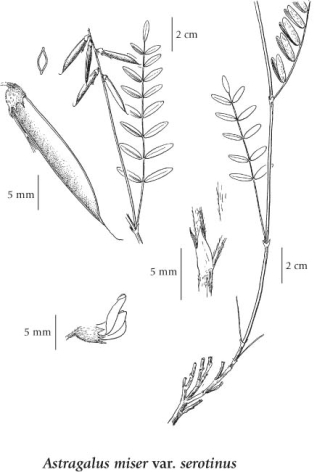Astragalus miser var. serotinus Douglas ex Hook. (A. Gray ex Cooper) Barneby
timber milk-vetch (timber milkvetch)
Fabaceae (Pea family)
Introduction to Vascular Plants
timber milk-vetch (timber milkvetch)
Fabaceae (Pea family)
Introduction to Vascular Plants
Map click to expand contents
Distribution of Astragalus miser var. serotinus
Click here to view the full interactive map and legend
Species Information click to expand contents
General:
Perennial herb from a taproot and branching stem-base, often with rhizomes; stems several to many, tufted, decumbent to erect, 10-40 cm long/tall, with short, appressed, unbranched (in ours) hairs.
Leaves:
Alternate, pinnately compound, 3-15 cm long, stalked; leaflets 7 to 21, linear to lance-oblong or oval, 5-30 mm long, greyish appressed-hairy on both surfaces or green and glabrous above; stipules lanceolate, 2-7 mm long, fused into a membranous sheath.
Flowers:
Inflorescence a loose to compact, axillary raceme of 3 to 20 more or less spreading, pea-like flowers, the racemes 1-10 cm long on slender stalks from shorter to longer than the leaves; corollas 8-12 mm long, from white or yellowish to bluish, the banner and wings with blue to pinkish-purple pencilling, the banner slightly longer than the wings and the purple-tipped keel; calyces 3-6 mm long, white or black appressed-hairy, the teeth triangular-awl-shaped, about 1 mm long.
Fruits:
Pods, narrowly oblong, nearly unstalked, drooping, glabrous to hairy, 1.5-2.5 cm long, flattened or not, becoming papery, 1-chambered.
Notes:
Two varieties occur in BC:
1. Leaflets equally hairy on both sides, the foliage silvery or frosted; calyces 4.5-6 mm long; keels 8-10.5 mm long.......................... var. miser
1. Leaflets glabrous or becoming so above, if hairy then the flowers much smaller; calyces less than 4 mm long; keels 6-8 mm long.............................. var. serotinus (A. Gray) Barn.
Illustration click to expand contents

If more than one illustration is available for a species (e.g., separate illustrations were provided for two subspecies) then links to the separate images will be provided below. Note that individual subspecies or varietal illustrations are not always available.
Illustration Source: The Illustrated Flora of British Columbia
Ecology click to expand contents
Ecological Framework for Astragalus miser var. serotinus
The table below shows the species-specific information calculated from
original data (BEC database) provided by the BC Ministry of Forests and Range.
(Updated August, 2013)
The table below shows the species-specific information calculated from
original data (BEC database) provided by the BC Ministry of Forests and Range.
(Updated August, 2013)
| Site Information |
Value / Class |
||
|
Avg |
Min |
Max |
|
| Elevation
(metres) |
927 | 420 | 1470 |
| Slope
Gradient (%) |
23 | 0 | 64 |
|
Aspect (degrees) |
221 | 14 | 360 |
| Soil
Moisture Regime (SMR) [0 - very xeric; 4 - mesic; 8 - hydric] |
3 | 2 | 5 |
| Modal
Nutrient Regime
Class |
D | ||
| #
of field plots species was recorded in: |
34 | ||
| Modal
BEC Zone Class |
IDF | ||
|
All BEC Zones (# of stations/zone) species was recorded in |
ESSF(1), IDF(22), PP(9) | ||
|
Source:
Klinkenberg 2013
|
|||
Habitat and Range click to expand contents
Mesic to dry grasslands, sagebrush flats, meadows, thickets, bluffs, roadsides, rocky slopes and forest openings from the steppe to lower alpine zones; common in BC S of 53degreeN and E of the Coast-Cascade Mountains, rare northward to 57degreeN; E to SW AB and S to C WA (var. serotinus) and S to ID, MT and NE WA (var. miser).
Synonyms click to expand contents
Synonyms and Alternate Names:
Astragalus decumbens var. serotinus (A. Gray ex Cooper) M.E. Jones
Astragalus serotinus A. Gray ex Cooper
Jones